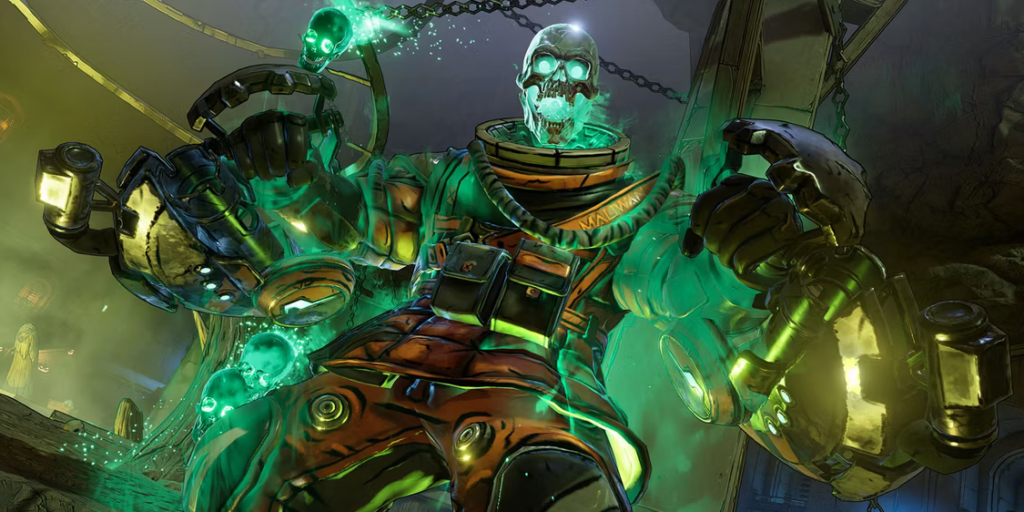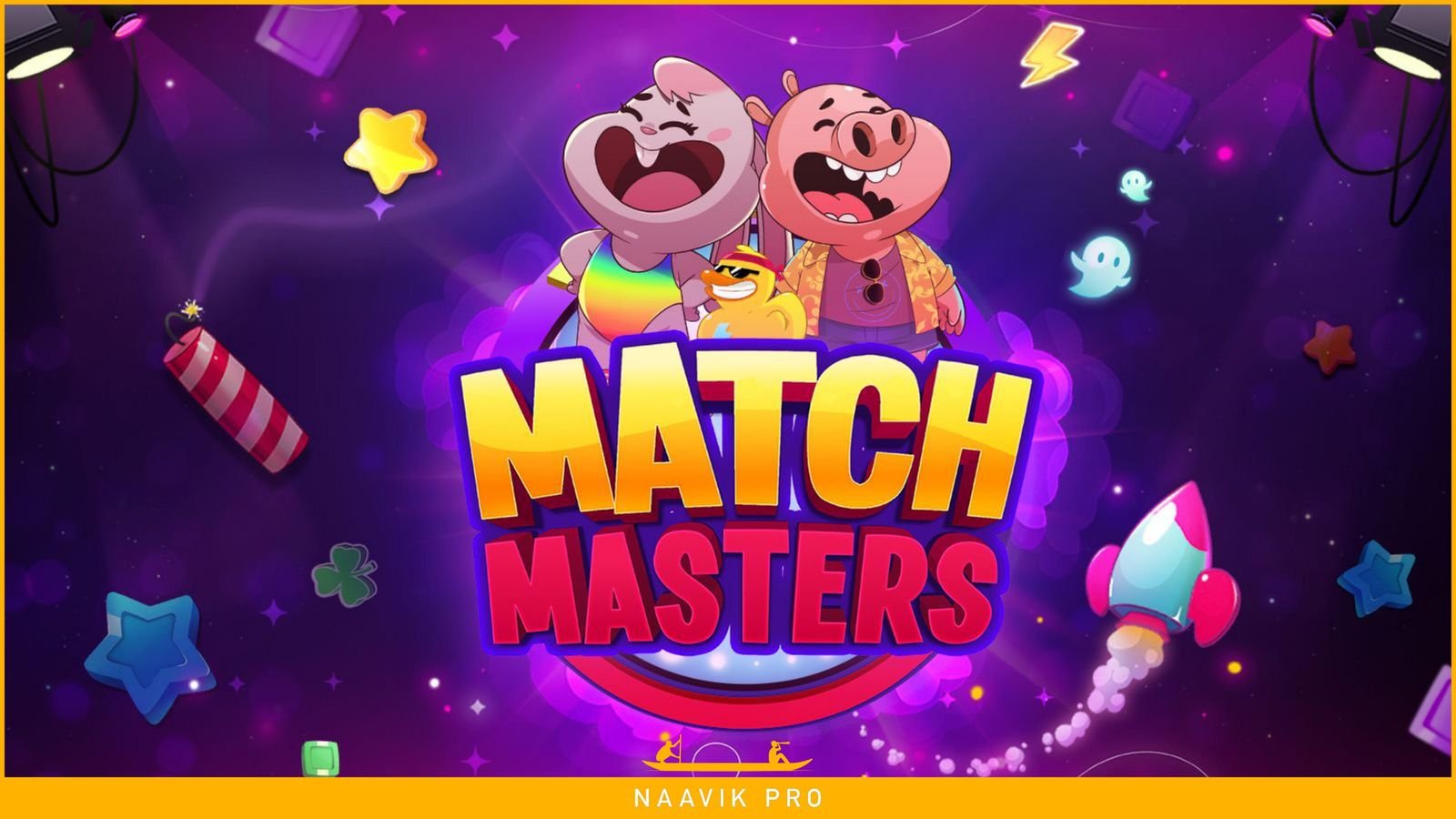
Executive Summary
- Match Masters is a F2P match-3 puzzle game with a multiplayer PvP-only core. Originally developed by Funtomic, which decided to drop it after its acquisition in 2017, Match Masters was picked up Candivore (formed by former Funtonic staff) in 2018 and resumed development.
- Candivore has raised $22 million in funding over the past two years to scale the game.
- As of Q1 2023, Match Masters has had a lifetime IAP revenue of $211 million over 42 million downloads.
- Match Masters is a unique combination of familiar Match-3 gameplay with real-time PvP multiplayer against other players in order to win trophies and rank up.
- The game has a unique booster economy that adds a risk-reward betting element to each match, and its 30-plus boosters of varying rarity are key to the game’s monetization.
- Over the last two years, Candivore has added features focusing on engaging and monetizing older endgame players like Legendary Leagues and Legendary and Special Edition boosters.
- The PvP-only nature of the game is in sharp contrast to the causal, fun, and relaxing experience the broad puzzle audience typically seeks, making it challenging to scale Match Masters to further growth.
Don't Stop Believin'
Match Masters is a mobile free-to-play game blending both Match-3 puzzle and PvP gameplay. It was originally developed and published in 2017 by Funtomic. The company was founded in 2008, based in Tel Aviv, Israel, and was primarily known for Kizi, a popular gaming website.
In 2017, Funtomic was acquired by Dutch-Turkish gaming and tech VC firm Azerion, which then decided to drop Match Masters. Former Funtomic staff — including Sahar Azran (VP R&D) and Tom Amel (Dev Team Lead) — founded a new studio, Candivore, and bought the Match Masters IP back in 2018.
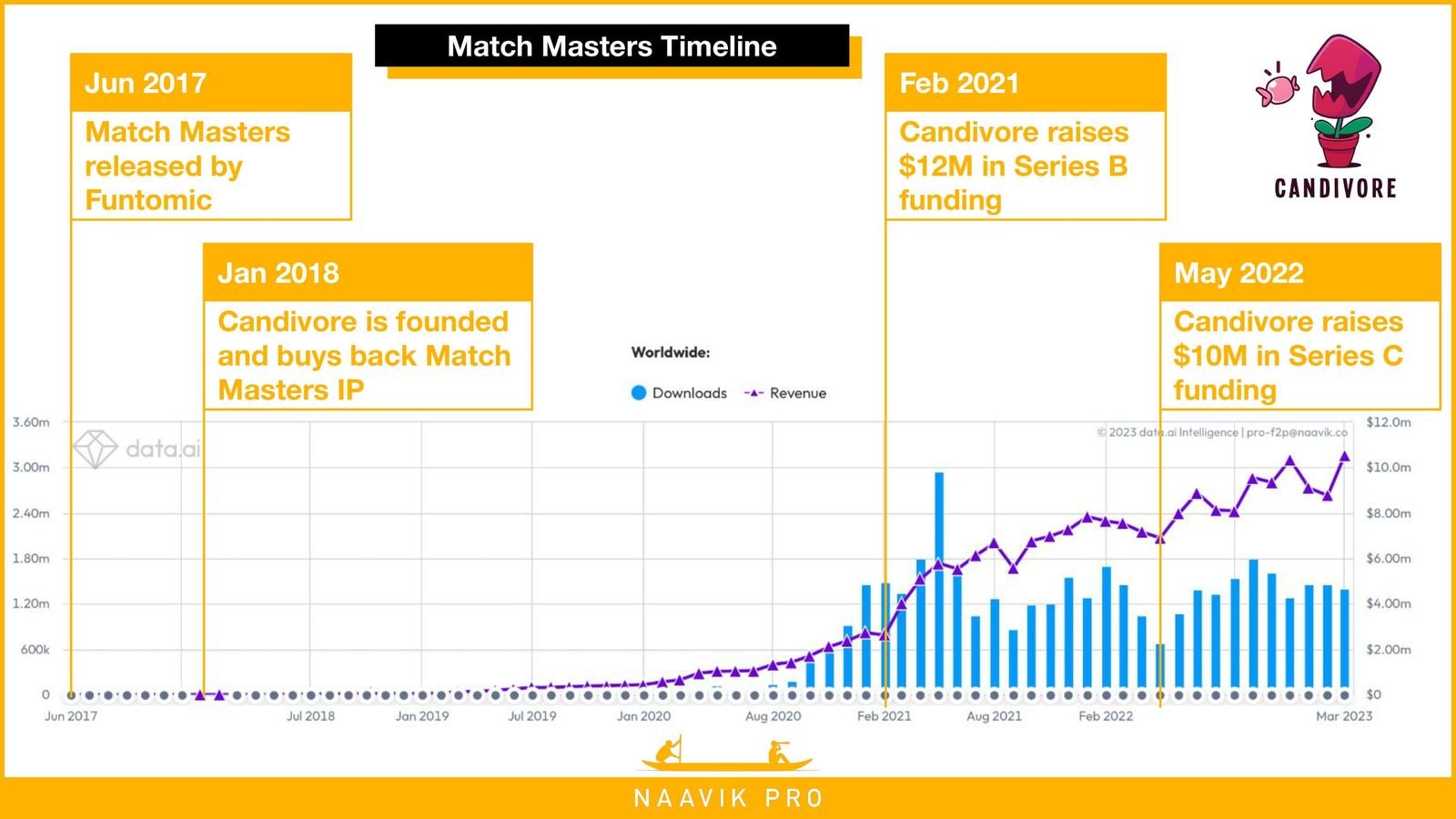
Candivore set out to prove it could grow the user base and revenue for Match Masters. After four years of gameplay iterations and live testing, the game had reached over 1 million MAUs with more than 5 million matches played daily by 2021. That made it the prime time to raise capital for scaling the game, and in February 2021, Candivore raised $12 million in a Series B funding round.
Since then, Match Masters has been on a growth trajectory in terms of downloads and revenue, securing another round of $10 million in Series C funding in May 2022. As of the end of Q1 2023, Match Masters has a lifetime IAP revenue of $211 million over 42 million downloads.
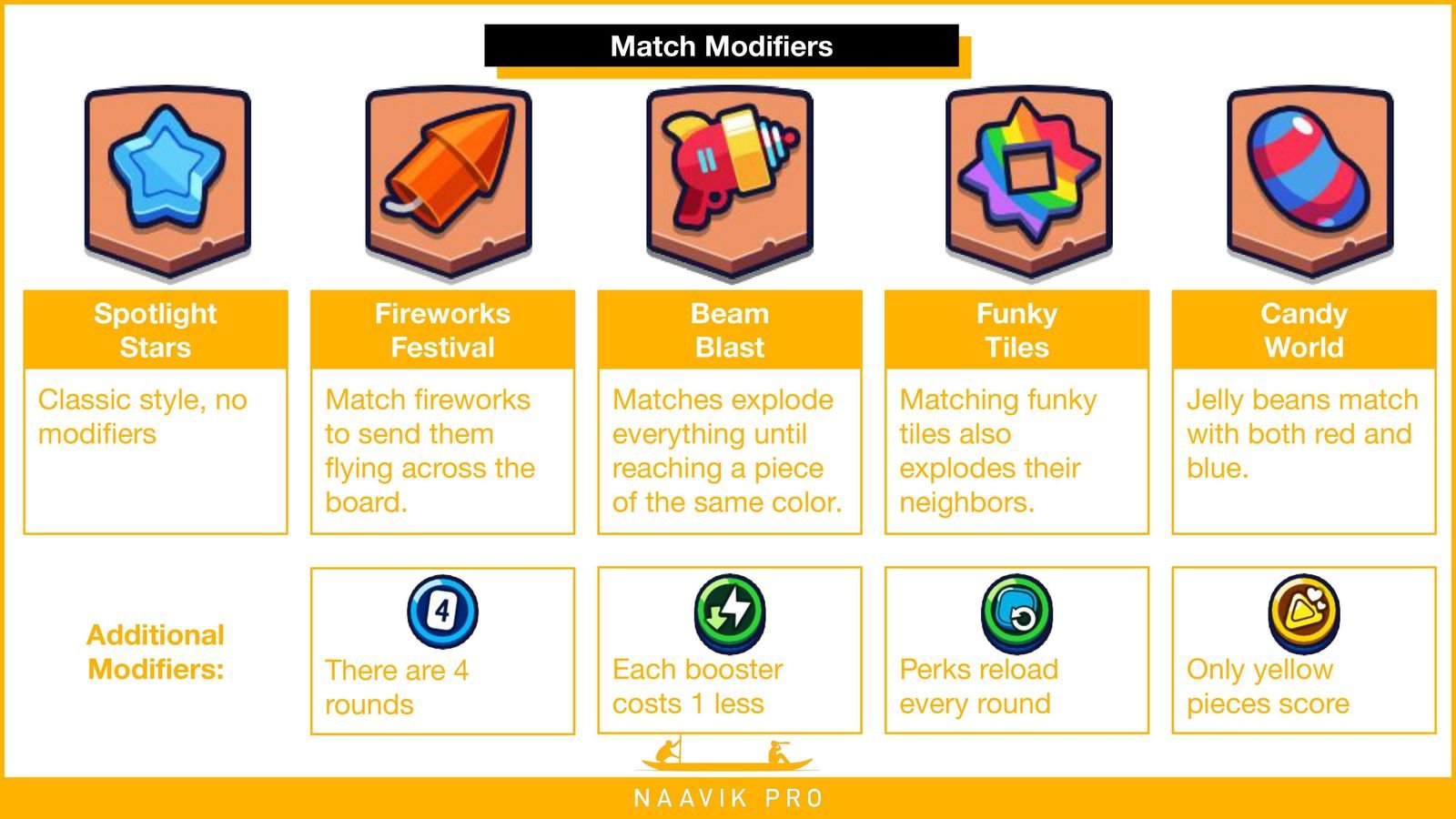
Match Masters puts a novel twist on the saturated Match-3 puzzle genre with a focus on a real-time multiplayer competition and a gameshow theme in which players compete against one another to win. Players make moves over rounds to match pieces on the shared game board to score points. Before starting a game, players can pick and use one of 30+ boosters to help score many extra points. You can watch gameplay breakdowns here and here.
Trophies are awarded for winning games by scoring more points than the opponent, and these trophies are the main way to progress through the game and unlock more features, modes, and rewards. The combination of these three elements — multiplayer, a booster economy, and trophy competition— makes Match Masters a unique player experience within the Match-3 puzzle genre.
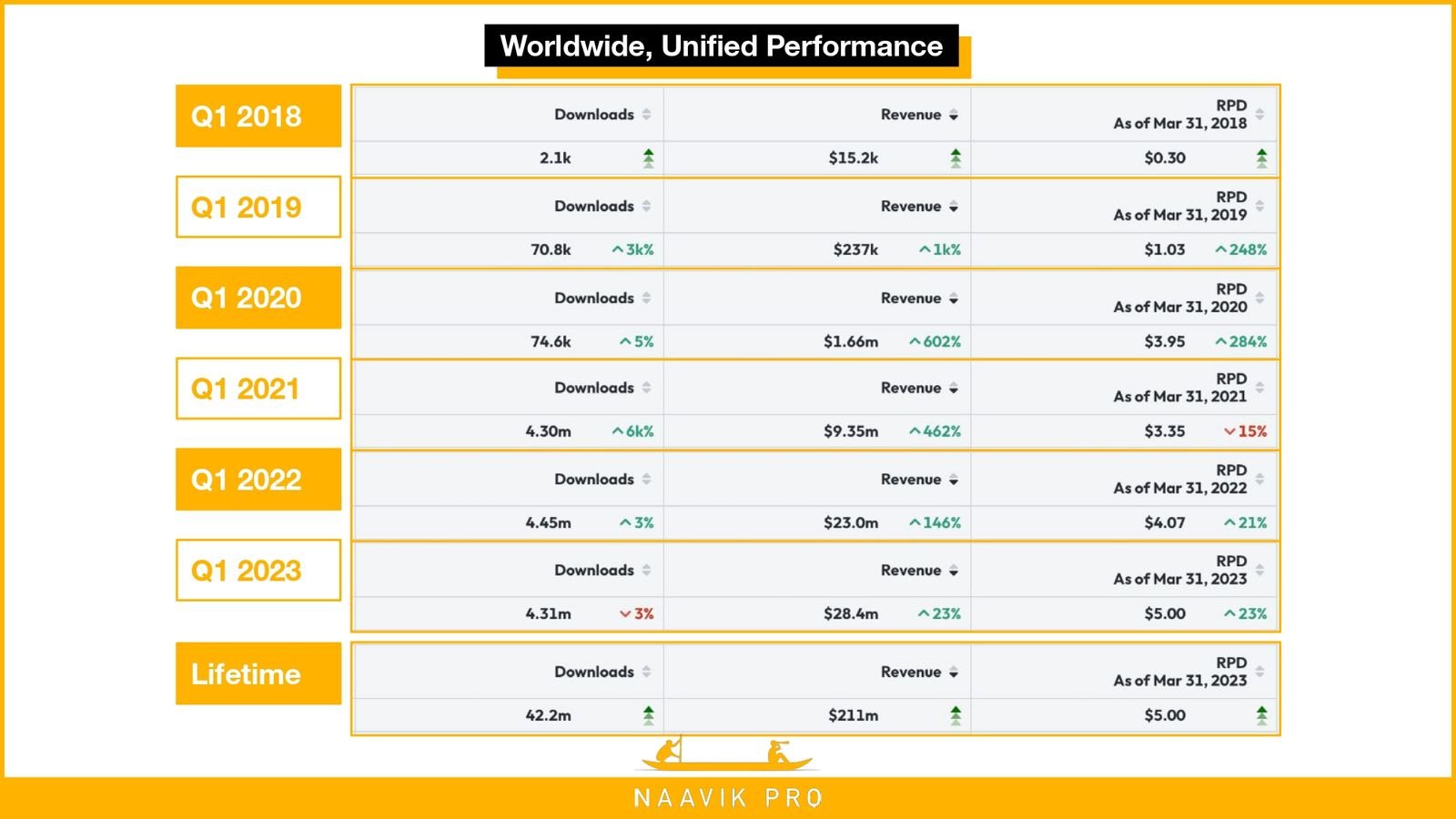
The year-over-year Q1 performance trends capture Match Master’s growth journey from zero to a top-grossing position with the team’s persistence and perseverance in their vision. After four years of development and live testing with Candivore’s 25-employee studio, the game had started signaling its true potential by the end of 2021.
Following its two rounds of funding, Candivore has been able to scale over the past two years with steady downloads and increasing revenue and RPD. In Q1 2022 compared to 2021, the game’s downloads remained roughly at 4.3 million, but revenue grew to $23 million, a 146% increase from the $9.35 million a year prior. Similarly, in Q1 2023 compared to 2022, the game continued to grow revenue even further by 23% YoY to $28.4 million and reached an RPD of $5 all with similar downloads.

Since Match Masters’ initial release in 2017, the match game market has significantly matured. Back in Q1 2017, four of the top six top-grossing match games were swipe Match-3 puzzle games, led by perpetual dominator Candy Crush Saga (CCS) with $103 million in quarterly revenue. At the time, Line’s link-matching game Disney Tsum Tsum and Peak’s blast game Toy Blast made the top-grossing list with $62.3 million and $33.2 million in revenues for the quarter, respectively. Fast forward to Q1 2023, and all six of the top-grossing Match games are swipe Match-3 puzzle games, continuing to be led by CCS and new entrant Royal Match (RM), which we covered in depth here.
Toon Blast, which makes the top-grossing list at No. 7 above, had a similar strategy to make the most social, competitive match game (with a blast core). It has had great success over the years, hitting $1 billion in lifetime revenue in 2019 and being a top revenue-generating title for Zynga and parent company Take-Two in Q1 2023.
The teams behind CCS and RM both attribute their success to adding more social and competitive features to fuel player engagement and monetization. Leaving out the merge games, Match Masters is entering the fierce match puzzle games market at No. 10 for the first time in Q1 2023, with $28.4 million in quarterly revenue and over 4.3 million quarterly downloads. As we covered in our puzzle genre report, Match games took 71% of the puzzle genre revenue in 2022 with $5.2 billion. Overall, puzzle games are doing well, and the new revenue baseline that began during the pandemic looks like it will remain.
The team at Candivore took a game few believed in and managed to turn it into a global success. This is something all developers strive for, but few would choose to invest four years into live testing and incremental development for just a chance at success. With revenue, downloads, and active users showing a plateauing trend in Q1 2023, Candivore needs to continue challenging itself to evolve Match Masters with the market. In 2022, the studio doubled in size to 50 employees to do just that.
In this deconstruction, we’ll cover the ins and outs of Match Masters and how its uniqueness in the genre appeases and, in some cases, alienates its audience, starting with:
- Market performance in top puzzle regions by revenue
- Similarities and differences from puzzle games in the swipe Match-3 core gameplay
- Progression and the game’s unique monetization strategy
- Live operations and the game’s odd content pacing
- Creative strategy and risks to broader appeal
Let’s first have a look at the game’s market performance.
The Market For Match Masters

The lifetime performance metrics of Match Master’s (MM) highlight the U.S. as its No. 1 region by total revenue ($61.8 million / 29%) and total downloads (5.36 million / 13%). This revenue is followed by the U.K. ($23.6 million / 11%) and Germany ($21.6 million / 10%). Both the U.S. and the U.K. boast a similar RPD of $11.40. This shows that the game is yet to unlock its revenue potential in Canada, Japan, and Germany, all of which make up the top five regions by revenue for Match games.
In terms of downloads, the game is very popular in the low RPD regions of India (3.69 million / 9%) and Brazil (2.72 million / 6%). Apart from AD revenue from these players, since the game is only played in real-time PvP, it's healthy to have a large concurrent player base to match and play with. Indonesia and Russia, which make up the top five regions by downloads for Match Masters, seem to have the potential for growing downloads. The U.S. ranking at No. 1 in downloads and revenue for MM is in line with being the regional leader for the match games genre.
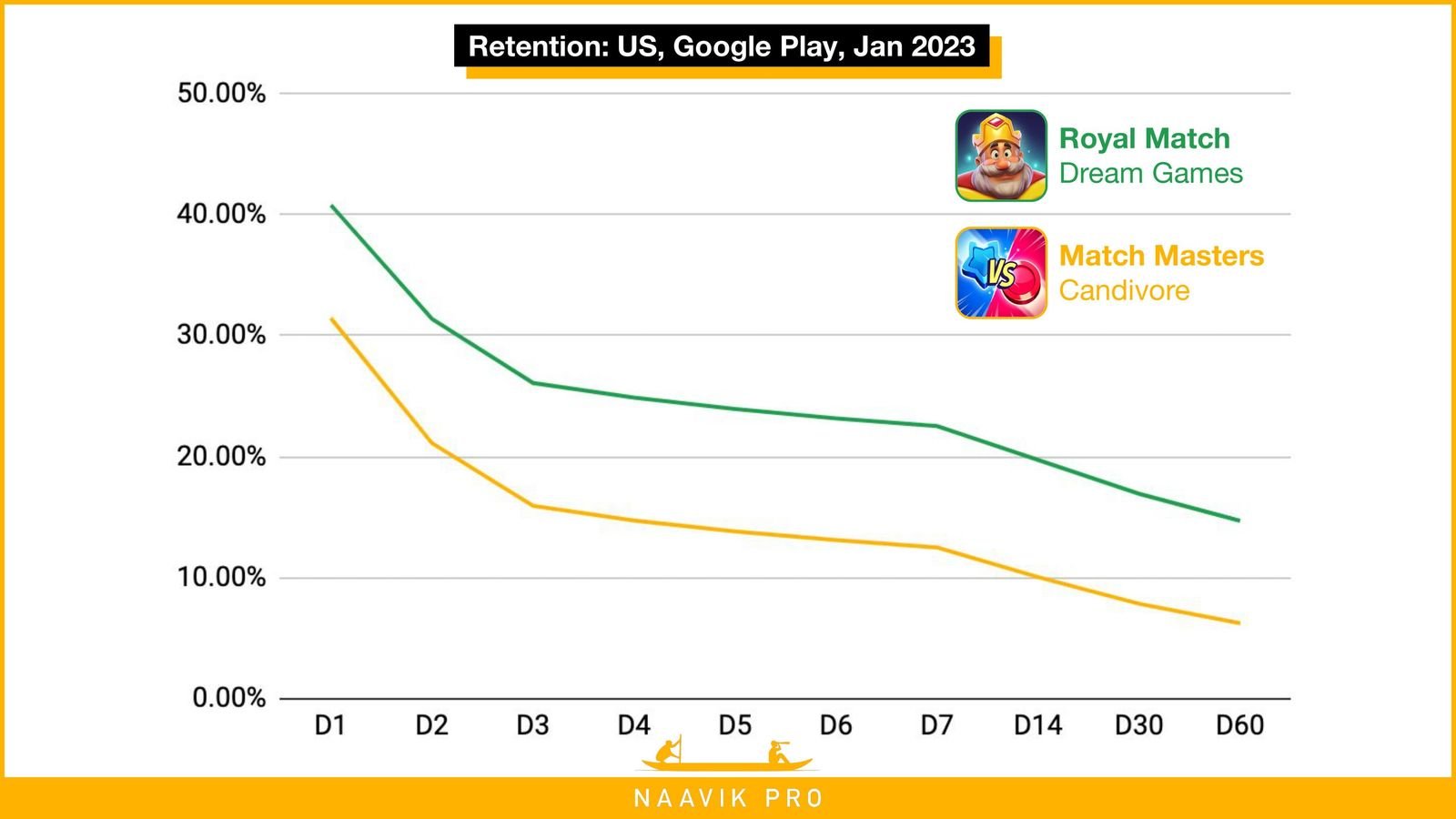
However, the game’s active players on data.ai show a plateauing trend for active users at an average DAU of 1.8 million since May 2021, though the downloads have maintained a consistent 50,000 per day. Looking at the game’s retention curve versus the genre-leading RM (U.S., GP, Jan 2023), MM’s retention is significantly lower. This is problematic when Candivore is spending on UA to compete for the same audience as other puzzle games.
Before diving deeper into what's driving this performance, let's take a closer look at the familiar-but-different Match-3 gameplay at MM’s core.
Match-3 Battle
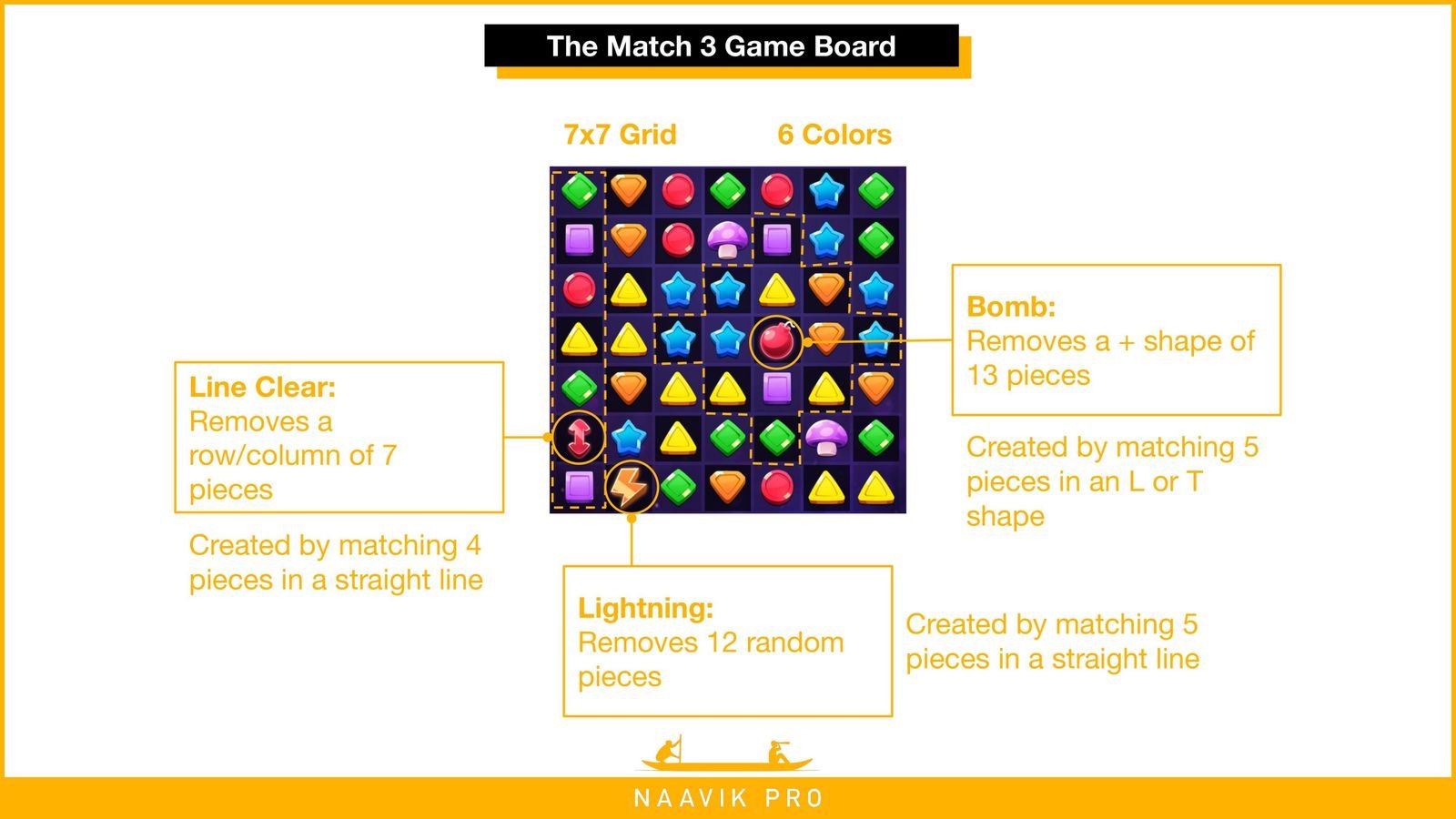
Every game in MM is a live, multiplayer, Match-3 puzzle competition in which the player and opponent take turns making matches on a shared game board. Matching and removing pieces from the board is how points are scored, with each piece removed scoring one point. The game takes place over several rounds where each player gets two turns over a 30-second timer. Once all the rounds are over, the player with the highest score wins the match.
The player and opponent bring a unique booster to every match. There are 30-plus boosters in the game with their own rarity, strategy, and effect. By collecting a certain number of blue star pieces (or red circle pieces for the opponent), they can charge their respective boosters. Once the booster is charged, it can be used without a move on your turn to score additional points. For example, the Firecracker booster requires six pieces for charging, and once activated it causes a small explosion removing five pieces from the game board (and scoring five points).
Other than boosters, players can bring two perks to the match. These are like in-game powerups found in most match games that can be used on your turn and do not consume a move. They can only be used once per match. For example, at the beginning of the game all players start with a Hammer, which can remove one piece from the game board, and a Shuffle, which can rearrange all the pieces on the game board.
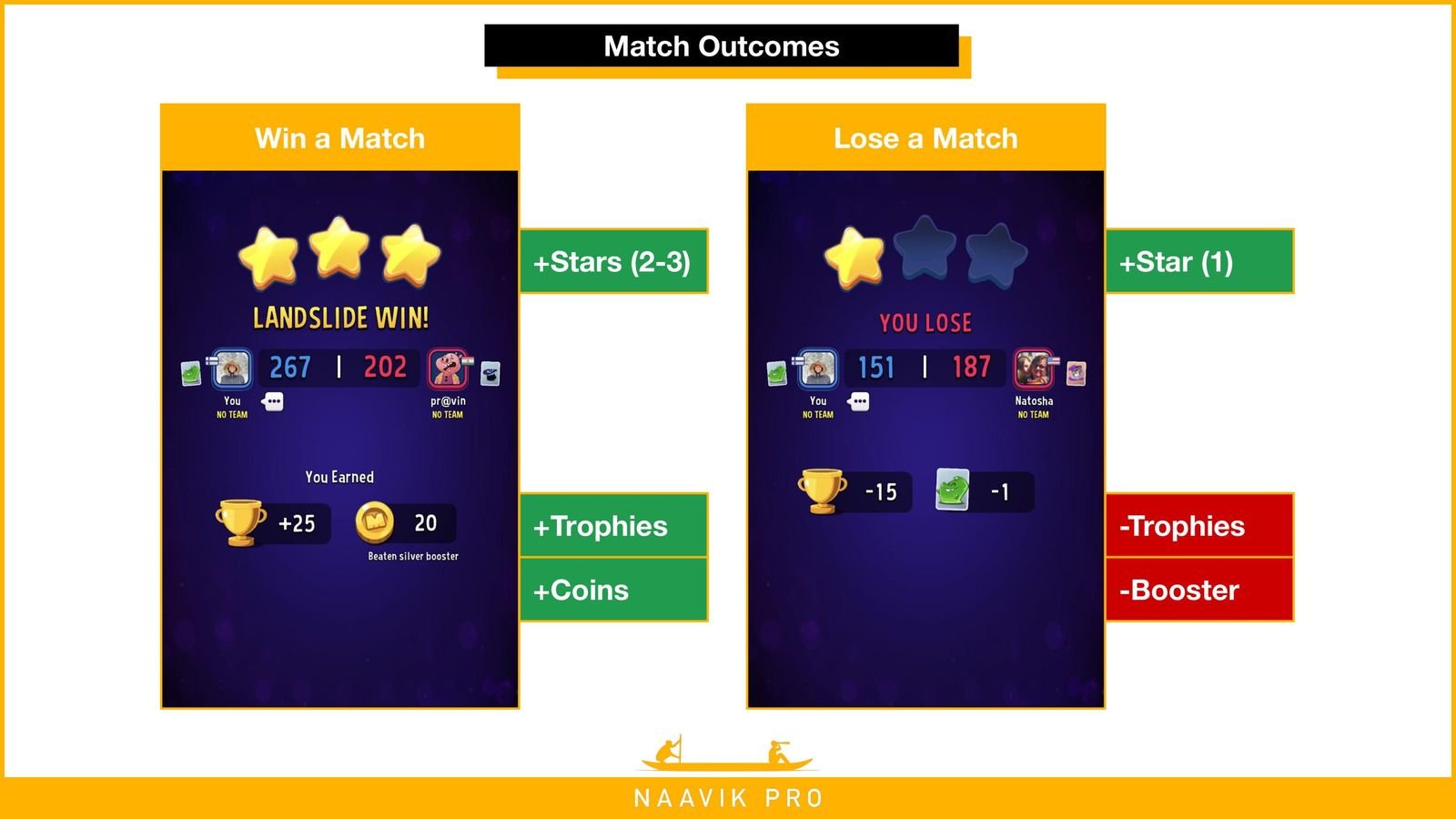
If a player wins the match, they earn two to three stars depending on their score, trophies depending on the rank and the boosters used by their opponent, and coins. If players lose a match, they still earn one star, but they lose some trophies and the booster used in the match. Trophies are the key progression vector for the game that unlocks leaderboard ranks and features. Stars are another progression vector, used in the game primarily for team play to unlock weekly team boxes or star race events to compete with other players on a leaderboard.

The Match-3 game board in MM works similarly to other Match-3 games, making the experience feel familiar and welcoming to most players. The game is played on a 7x7 grid and uses six color pieces. When a match is made, new pieces cascade from the top as gravity moves pieces downward till the board is full. The use of six colors is quite high compared to other games with larger boards and fewer colors. For example, Candy Crush Saga uses a max of a 9x9 board with mostly four colors, whereas Royal Match (RM) uses a larger 9x11 max board size with mostly four colors.
These larger board sizes and fewer colors in other match games make them more auto-matching cascade friendly, increasing the likelihood that more pieces match when cascades happen after a player move. In MM, due to the smaller board and more colors, it's very unlikely that new pieces cascade and auto-match after a player takes a turn. This helps MM players have more control over the board and their progression and hence more agency in scoring points.
Players can match three pieces to remove them, or match more pieces to create special pieces and get an extra move. Matching four pieces in a straight line creates a Line Clear piece (similar to Rockets in other games) and matching five pieces in a L or T shape makes a Bomb piece (similar to Bombs in other games). Matching five pieces in a straight line creates a Lightning piece (a Color Bomb in other games), and its functionality is a key difference to most other Match games.
In general, the Color Bomb piece removes all pieces of the color it's matched with from the board. In MM, Lightning works differently by removing 12 random pieces from the board. This decision again helps with avoiding chances of auto-matching cascades — if only one color was removed, there would be more chances of auto-matches by the cascades. By removing 12 random pieces, the weight of six color pieces on the game board remains the same, reducing the chance of auto-matches.
Since the board is shared and players take turns making matches, players can strategize to make the most favorable matches as well as hinder their opponent from charging their booster by matching those pieces. Without too many auto-matching cascades, given the use of six colors, players feel skilled and in control of their point progress. This makes the gameplay in MM feel more strategic and intent-driven when compared to the more luck-based cascade nature of most match games. This is a double-edged sword, though, as the luck-based cascades in other match games, with their more frequent auto-matching, often create surprising, joyful, and explosive moments.
The boosters are a unique aspect of MM and help alleviate some of these missing explosive moments.
Booster Buffet

MM does not have the traditional puzzle games’ Lives economy to play levels/matches. Instead, before every match, players need to pick a booster to start, making them a sort of energy system to play matches as well as a prime monetization vector. As mentioned before, these boosters can make the most impact on the outcome of any game. If the player wins the match, they get to keep their booster. The booster is lost if they lose the match. To play the next match, players again need to pick a booster from their inventory, buy new boosters if they have run out, or wait for their basic boosters to refill over time.
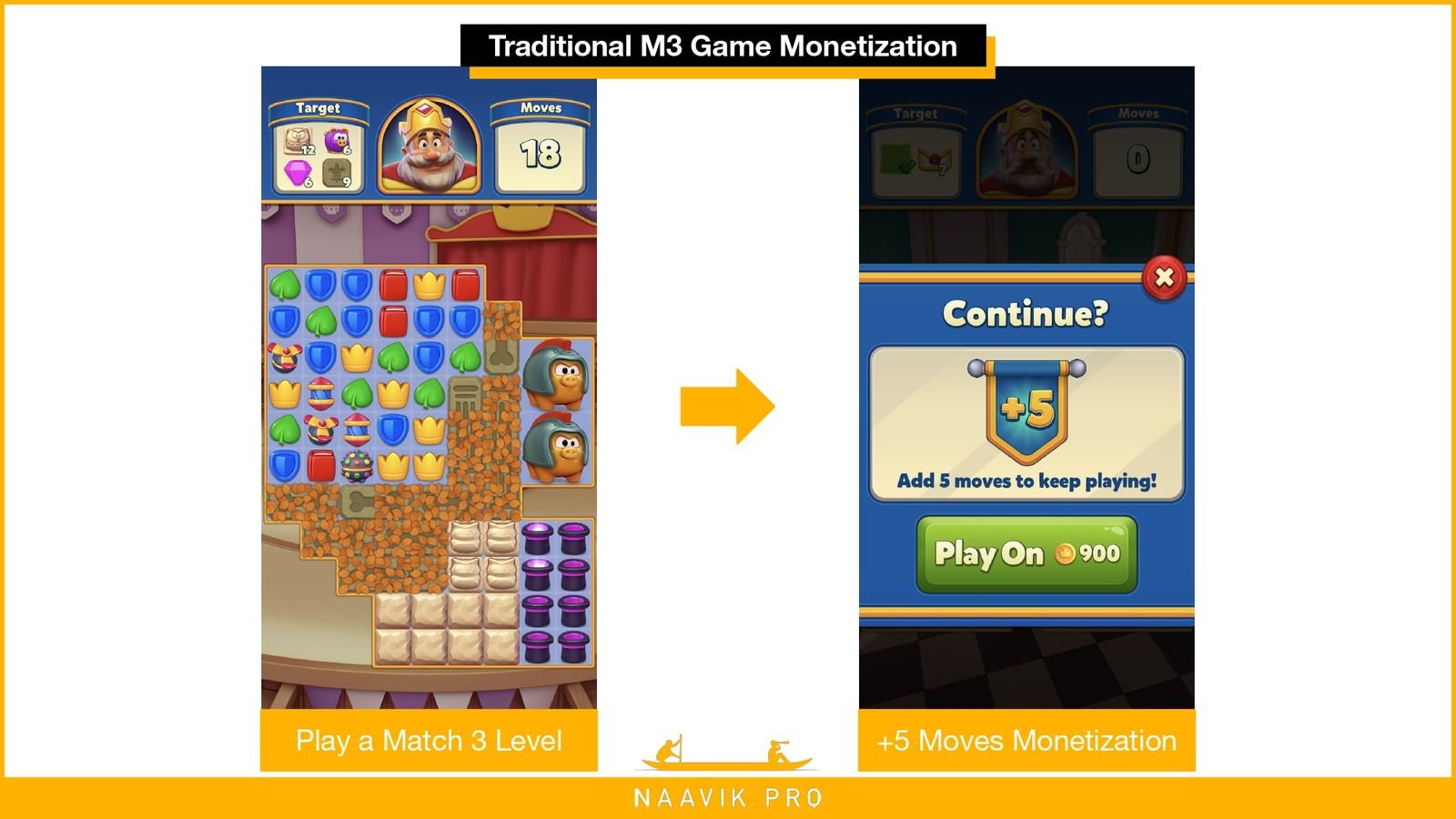
This booster-centric economy is most distinctive from other match games, which rely on players buying +5 moves to complete match-3 levels after running Out of Moves (OoM). This traditional OoM economy, which is at the heart of games like CCS and RM, happens at the end of a match-3 level when players are close to winning the game. In MM, players have to make a decision on buying and choosing boosters before the match and have no way of continuing to play once the match is lost. To put it another way, over several Match-3 games, the boosters are consumed when choosing them at the start of the match, whereas in traditional Match-3 games, the +5 moves are bought and consumed at the end of the match.

There are several types of boosters in MM in increasing rarity, starting with basic Bronze boosters that either cost 50 coins (the game’s primary currency) or require you to wait an hour to refill for free once consumed. Silver and Gold boosters cost 100 and 200 coins, respectively, and are slightly more powerful than the Bronze boosters. For example, the Bronze Rubber Duck booster removes the middle row from the board (seven points), whereas the Gold Lazer Beam booster removes a chosen row and column from the board (13 points). Both these boosters require players to collect seven blue star pieces from the board to activate.
The diamond boosters are more powerful and come in three tiers costing from 400 to 1000 coins. For example, the UFO costs seven pieces to activate and removes two colors from the game board (for about 16 points), making room for more potential matches. Next are the Legendary and Special Edition boosters, which are the hardest to acquire as they are primarily gained from gacha boxes, the Mystery Piñata. These are super effective in matches. For example, the booster Doctor Color Special Edition costs seven pieces to activate and changes two colors on the board to match another color twice, making more matches and special pieces on the board (and +32 points).
Though this may seem like the game is one-sided to the player with the rare and more powerful booster, it cannot guarantee a win. Although playing with more rare/powerful ones does give an advantage more often than not, like other puzzle games MM is a mixture of skill and luck, with each match varying in challenge but not impossible to beat. Buying boosters and perks with real money does give a clear advantage over others, making the game skew more pay-to-win. This is alleviated by matchmaking and maintaining a good pass rate for all players, allowing the audience to be super competitive even when not spending real money.
The game pairs players for a match using Trophies, a key progression vector for the game.
The Trophy Road

Trophies are awarded for winning matches and deducted for losing matches, marking the player’s progress in MM. Progression is broken into ranks as players accumulate trophies, and their position is secured with every new rank (losing trophies cannot take them below their last secured rank). The trophy road gradually unlocks more ranks, boosters, events, and game modes. Some of the key unlocks and their corresponding trophy costs are listed below:

Reaching 3,800 trophies unlocks the first major portion of the game, including all boosters, teams, and most event and game modes. Players can win 25-50 trophies per win and lose five to 15 trophies per loss, based on several factors like player ranks as well as beating opponents with higher trophy ratings and beating opponents with higher rarity boosters for more trophies.
Reaching 3,800 trophies to unlock most features of the game requires playing around 150 to 250 total matches. This takes a long time to unlock most features and modes compared to other Match games and is a potential area for improvement. By unlocking more content like main events early on, players can make gratifying parallel progress and chase multiple rewards, improving the early game stickiness.
Take Teams as an example. It's a common early feature in most casual puzzle games to engage players as a group (usually 50 players). In MM, it would take 50 to 100 matches to earn 1,400 trophies and unlock them, whereas in RM, for example, Teams unlock at level 20. This makes a sizeable time difference from joining new players in Teams on your first session or Day 0-1 to joining other players in Teams in Week 1 for MM. Similarly, the main events in MM unlock much later and hence can impact the engagement of already-committed players rather than influencing fickle early players trying out the game.
Once the Master Ranks are unlocked at 3,800 trophies, all the game boosters and most features are unlocked, making them a more competitive ladder to climb. The Master Ranks range to 30,000 trophies (1,000 to 2,000 matches) where most of the audience is largely playing. After reaching 30,000 trophies, the Legends League is unlocked. This is a seasonal ladder of rewards where the most elite endgame players compete. Each season lasts a month and prizes are distributed according to a player’s end-of-season rank. This ladder goes up to 200,000 trophies (5,000 to 10,000 matches) and resets back to 30,000 trophies at the start of a new season.
This trophy road structure has evolved over time, with the Legends League being a new recent addition, making for three disparate progression experiences:
- A more linear progression ladder unlocking boosters and features at the start
- A more competitive progression ladder in the Master Ranks
- A seasonal competitive ladder in the Legends League
Though each helps with engaging players with different amounts of time investment in the game, most other casual match games feature two disparate progression experiences:
- A saga level funnel that unlocks most features by levels 20 to 50
- An end-of-content leaderboard (recycling old saga levels) that engages players between new saga level releases.
Players are able to play all events, features, and seasonal content while being on saga or at the end-of-content leaderboard. Since seasonal content is locked to the Legends League and Main Events locked to the Master Ranks in MM, this is close to unlocking seasonal content and events only for players who complete all saga content. Seasonal content and events can be used more effectively by unlocking early for all players. This would deepen engagement with more parallel goals to chase as well as improve stickiness with a more rewarding player experience.
Match Mixers

To keep matches from feeling repetitive, MM has Match Modifiers that unlock at 100 trophies and apply a special twist to every match. For example, the Funky Tiles modifier marks some tiles on the board with a rainbow edge, and creating a match on them explodes their immediate neighbors in a + shape. The Candy World modifier drops multicolored Jelly Beans on the board that match with both red and blue pieces. Match Modifiers are unlocked one by one in the early ranks and affect all matches in that rank. By the time players reach the Master Ranks, they will have unlocked all of them. Once players reach the Master Ranks, they are shuffled into a mode called Daily Mode that randomizes them every day for regular matches.
Match Modifiers are marked before starting a match or game mode and help players choose boosters that would best take advantage of them. Some matches and game modes can have up to two more additional modifiers, though these are simpler in nature, like changing the number of rounds or turns or reducing the cost of charging boosters. The game begins with no modifiers and quickly onboards players to new modifiers as they rank up.
This twist in gameplay keeps matches feeling varied, but it’s sometimes hard to communicate. For example, an early modifier Beam Blast explodes all pieces after a match until reaching a piece of the same color as matched. This effect is not well communicated to players and is chaotic to choreograph and read on the game board, which makes the game feel more random.
Live Operations

Since its release, MM has slowly added features from other successful games in the genre, like Teams for collaborative play and Stickers for collection enthusiasts. The game also has several reskinned variants of its collection event to earn bonus rewards like:
- Booster Blast Event: Collect Lightning points for winning matches, with more points for higher rarity boosters
- Color Circus Event: Collect Drumroll points for winning matches, with different color pieces scoring different points
- Cookie Crunch Event: Collect Cookie points for winning matches, with more stars earning more points (also used for Jurassic Run Event for collecting Dino Egg points as well as Digging Diamonds Event for collecting Diamond points)
These events have increasing milestones to reach within 1-3 days and have become staples across match genre games like:
- The Book of Treasure / Propeller Madness in Royal Match
- The Cube Heist / Sky Mission in Toon Blast
- Various reskinned cascade events in Homescapes, Gardenscapes, and Fishdom
Depending on the engagement of players, there is always a next reward milestone to reach, with only the top players ever managing to reach the final milestone.
Over the last two years, the focus at Candivore seems to have been solving for elder players sitting at the top league with a high inventory of old boosters. The addition of newer, more powerful Legendary and Special Edition boosters (with one new booster being released every two months), as well as the Legends League, is to further engage those elder players with a resetting trophy system in a more competitive ladder supported by the newer aspirational boosters. This seems to be paying off in terms of increasing revenue and growing RPD, as seen above.
A unique addition last year was an event to add more social spin to the game’s core PvP mode, Match Rumble.
Ready to Rumble
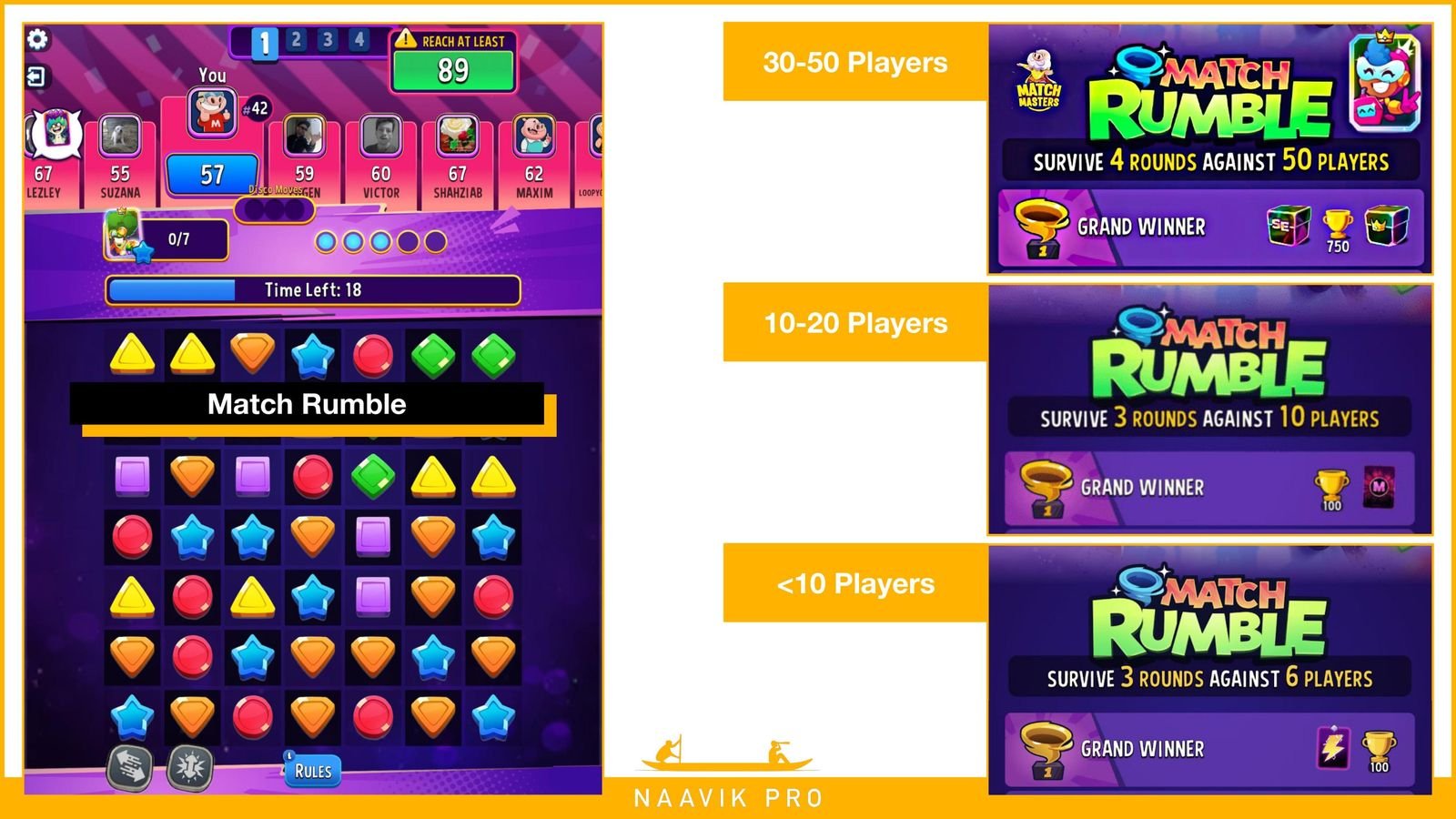
Match Rumble is a battle royale-style event that lets players play a Match-3 game against multiple players at the same time. In each game, players have a set amount of opponents, rounds, timers, and turns to play with. The mode has a similar setup to regular matches, where players are shown the Match Modifier and can choose the booster and perks to bring to the match. To advance in rounds in Match Rumble, players need to remain in the green zone by scoring above a certain number of players. The last player remaining with the highest score in the last round is the winner of the match.
Candivore has done a fantastic job at capturing the frantic nature of a Match-3 battle royale with an excellent user experience. Players play on their individual game boards in this mode and do not have an effect on other players (like hindering their booster charging by matching certain colors). Where the normal play mode sinks 1 booster from the game economy of the losing player, Match Rumble sinks 49 boosters in a 50-player match! This is great for game economy, though the rewards for this mode are very high as well and include 100+ trophies and Legendary boosters.
And sinking boosters is at the core of the game's monetization strategy.
Booster Sales

The top IAPs in the game are Home Screen Offers, which bundle a few boosters together with some coins and stickers in limited time offers ranging from 1 hour to 1 day and cost $1.99 to $9.99. These offers are segmented according to player progress and spending habits and the game runs a few of them daily. The other half of the top IAP concerns coin purchases, which are then used to buy unlocked boosters with prices ranging from:

Since most players will attempt to use Diamond boosters or above, the $1 to 3 price range is similar to other match games charging about $2 for +5 move purchases. The key to booster monetization in MM is that boosters need to be unlocked before they can be purchased for coins. For example, if players collect a Diamond booster from rewards or buy one from an offer, once they use and lose it in a match, they can buy more using coins. This is for a limited period only, as after one day the booster expires and is removed from the player’s booster inventory and is ineligible to be purchased for coins.
The booster system is summarized with an example below:
- Players bring one booster of their choice in every match in all game modes (for example, the Legendary UFO booster)
- The losing player loses the booster used in the match (the player had one UFO booster that got consumed in the match)
- Players can buy more of the booster for coins before it expires in a day (the UFO booster is still in the player’s booster collection, with a count of 0 per day. And now the player can buy more of these for 800 coins before the expiry timer runs out)
- Once a booster expires, the player needs to earn it again (the player chose not to buy more UFO boosters, and after the timer runs out it’s removed from the player’s booster collection).
This unique take on the Match economy adds a gambling-style risk-reward wager to the experience. Players can choose to risk using rarer and more expensive boosters to win matches, but the booster is lost if they lose a match. In the normal play mode, there is always one booster that is consumed by the losing player, whereas in the 50-player Match Rumble mode, the game can sink 49 boosters with every match.
The Legendary and Special Edition boosters are sold in bundles costing $15 for random Legendary boosters and $22 for random Special Edition boosters. They are late-game boosters unlocked at 16,000 trophies, and the game limits their sale and acquisition to maintain its balance due to their overpowered nature.

MM also features rewarded video for ad monetization and bonus daily spins, a coin doubler after winning a match, and shuffling booster rewards from a reward box. All of this gives nonspenders an avenue to monetize. One aspect of the IAP curiously missing from the top IAPs are monthly subscriptions. They feature a huge list of benefits shown in the image above and range from $5.49 to $20.99 on a monthly basis. This asking price is way above the general price of comparable season passes in casual puzzle games that range from $4.99 to $9.99 monthly.
Even Scopely’s Yahtzee with Buddies, a casual competitive dice-rolling game, prices its monthly subscription pass at $7.99. MM must find a more streamlined subscription or season pass with fewer but more effective benefits at a more alluring price for this demographic.
With social PvP at its core, it is no surprise that MM uses these elements in acquiring its players.
Competing Creatives

MM uses its game show theme heavily in UA, highlighting the PvP focus of its game as well as the familiarity of its Match-3 game board. The colors used tend to be more purple-pink to attract its core demographic of 35-plus females, though its competitive nature helps skew the gender demographics more equally to nearly 50% male-female (U.S., Unified, March 2023).
Match Masters also has celebrity TV and online AD campaigns, primarily in the UK, featuring legendary singer Robbie Williams and actor and football star Vinnie Jones. These were used from May 2022 to propel downloads even further after the series C $10M funding (link).
In a genre market dominated by fake gameplay, “sadvertising,” renovation, makeup, dress-up, and mini-games, it's refreshing to see MM using its core promise of multiplier match-3 gameplay to acquire players. This UA strategy sets the game apart from its many competitors while maintaining familiarity with the puzzle audience.
Six Years Down, Forever to Go

The team at Candivore has made a significant splash in the red ocean market of casual Match-3 puzzle games by focusing on an innovative multiplayer PvP experience at its core. With the recent additions of Legendary Leagues, as well as Legendary and Special Edition boosters, the team has managed to retain its most loyal elder players by giving them more content to play and compete in.
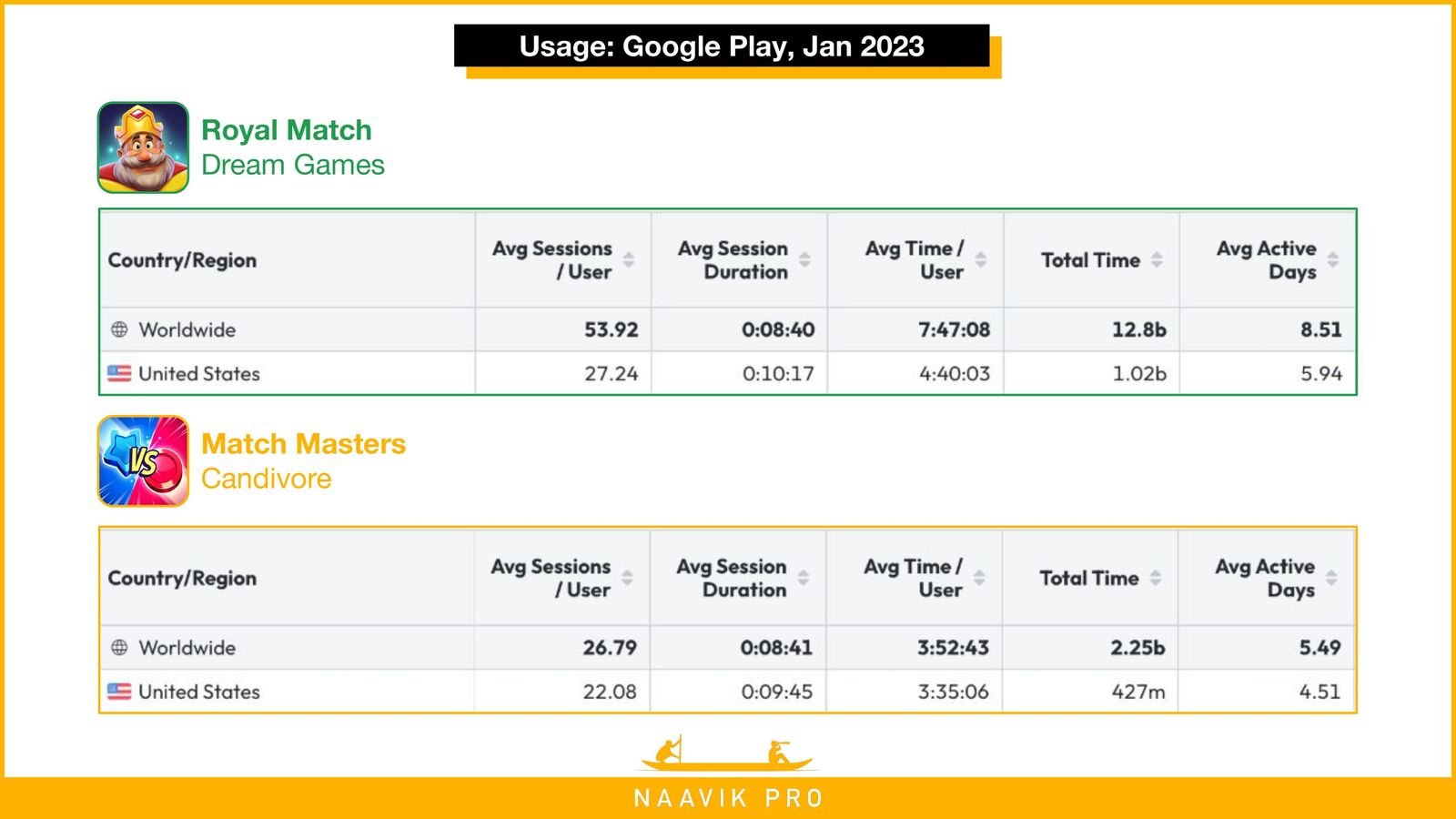
The stark difference for MM to make up for is its usage difference shown above. Players play MM for fewer sessions and days per month compared to genre-leading Royal Match. Players play casual games for various motivations that the games’ various features and events cater to, forming an intricate net of goals and rewards for an audience to chase. In MM, most features and events unlock after a much longer time investment in the game, and with not many ways to progress or goals to chase, only the most competitive social players are left retained in MM.
Early onboarding into Match-3 PvP games needs a cushioning revamp, allowing players to have a much higher win ratio in the early game. This is a strategy used by the recent casual PvP card game Marvel Snap (that we covered here) and also highlighted by Supercell as a key factor for engaging a wide audience by keeping the PvP gameplay feeling more casual and fun in Clash Royale.
Additionally, MM needs to experiment with unlocking most features and events on a much shorter D0-D1 timeframe to tackle early retention issues like its competitors. Allowing players to join teams this early and chase unlocking collaborative rewards, sharing resources, and helping each other out can increase early retention by satisfying players’ altruism. Multiple events running in parallel can signal goals to players to engage and chase to completion. Players are more likely to return after satisfyingly reaching multiple reward milestones to tasks/event milestones that they’ve left incomplete.
Another short test to increase D0 engagement would be to remove the effect of the timer from the first few games entirely. Timers are known to be stressful and increase intensity, and that’s in part why they have faded from use in casual Match-3 games (apart from being used in the skippable nightmare levels). This is reason enough to test MM without a timer when onboarding new players. The test could involve using bots that wait indefinitely for players to make moves or only starting a 10-second countdown after 20 seconds, maintaining the current 30-second timer but not triggering players' stress from the get-go with a countdown.
Candivore has grown MM to its current heights in the crowded Match-3 puzzle space with a focus on competitive players. This is something Peak did with Toon Blast after Toy Blast, and much more recently, Dream Games has been experimenting with Royal Kingdom as a more competitive follow-up to Royal Match. Yet, Match Masters’ PvP-only core is challenging to scale to a broader audience as it conflicts directly with having a casual and relaxing experience. Unless the studio is able to make the early game substantially palatable for a more casual audience, the current trendline of plateauing DAU may signal the end of growth for this fast-rising game.




